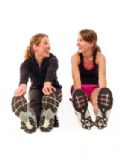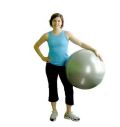|
When it comes to getting fit and healthy, there's no magic pill or secret shortcut for reaching your goals. Whether you'd like to drop a few pounds, build more muscle or achieve a more dramatic, life-changing weight loss, the recipe for success is proper nutrition and effective exercise. Ideally, that exercise should be a mix of strength training and cardio (defined by the American Council on Exercise as "movement that gets your heart rate up to improve oxygen consumption by the body"). Seems simple enough—but how do you determine which type of exercise is best for you? Over the past few years, there's been a lot of buzz around high-intensity interval training (HIIT), which is a form of cardio that alternates between short intervals of maximum intensity (usually between one to three minutes) and longer periods of recovery (around two to four minutes). The idea is to keep the body guessing by constantly switching up intensity levels, which can burn more calories in a shorter amount of time. HIIT definitely has its benefits, but it's not for everyone. People with heart conditions or other medical concerns—or those who are new to exercise—may not be able to safely accommodate the high-intensity intervals. Fortunately, HIIT isn't the only way to reap the benefits of cardio workouts. To Ramp Up Results, Slow It DownFitness has come full circle. After the industry's long-term love affair with HIIT, there's been a return to traditional endurance-based cardio. Low-Intensity Steady State cardio (LISS) is essentially the opposite of HIIT, involving longer periods of exercise at a lower heart rate in the aerobic range (typically 60 to 80 percent of maximum capacity). Shane Andrew Noble, a certified personal trainer Reasons to Love LISSExtended, lower-intensity workouts have been linked to a myriad of benefits:
There are countless ways to implement low-intensity exercise. Kim Schaper, a certified personal trainer and nutrition coach, prefers walking and elliptical training. "Walking has tremendous benefits, especially the day following a HIIT session," she says. "It's been proven to reduce cortisol, relieve stress, balance hormones and make us happier and less stressed." For those new to LISS, Schaper recommends starting with 30 to 60 minutes of light walking each day. For best results, she also suggests mixing in some restorative yoga, stretching, meditation or breathing exercises. Other slow and steady activities include jogging, swimming, cycling and hiking. In the gym, Mclean uses a three-part LISS workout that combines three, 10-minute intervals:
According to Noble, an average LISS workout would be 30 to 45 minutes of cardio, while keeping the heart rate as close as possible to the fat-burning zone. "The easiest and most accurate way to measure intensity is to elevate to 70 percent of one's maximum heart rate," he says. As always, be sure to consult with a physician or health professional before starting a new exercise program. |







